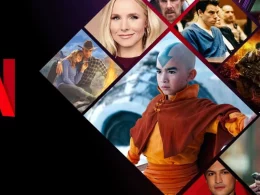Introduction
In recent years, the film industry has undergone a seismic shift, largely driven by advancements in technology and the rise of streaming platforms. This transformation has affected every facet of the industry, from production and distribution to how audiences consume content. This article delves into these changes, exploring how technology and streaming have reshaped the landscape of cinema.
The Evolution of Film Technology

Technological innovations have revolutionized how films are produced, offering filmmakers greater creative flexibility and reduced costs. High-definition digital cameras, CGI, and advancements in editing software have democratized the filmmaking process, enabling independent filmmakers to create high-quality films without requiring a major studio’s backing. With cloud-based editing platforms and virtual production methods, filmmakers can now collaborate globally in real-time, further streamlining the process.
-
Digital Revolution
The transition from analog to digital has been one of the most significant technological advancements in the film industry. Digital cameras have replaced traditional film cameras, offering filmmakers greater flexibility and cost-efficiency. This shift has democratized filmmaking, allowing independent creators to produce high-quality content without the need for expensive equipment.
-
Visual Effects and CGI
Advancements in visual effects (VFX) and computer-generated imagery (CGI) have expanded the boundaries of storytelling. Filmmakers can now create stunning visuals and complex scenes that were previously impossible or prohibitively expensive. This technology has opened new genres and creative possibilities, enhancing the viewer’s experience.
-
Editing and Post-Production
Digital editing software has revolutionized post-production, making it faster and more efficient. Filmmakers can now edit films with greater precision and creativity, incorporating complex effects and transitions that enhance the narrative. This technology has also facilitated remote collaboration, allowing post-production teams to work from different locations seamlessly.
Tech Revolution in Filmmaking
Technology has changed how movies are made. Filmmakers now use digital cameras and special effects to create stunning visuals. These tools are cheaper and easier to use than before. Even independent filmmakers can now produce high-quality films without huge budgets. Cloud editing has also made it possible for teams to work together from different parts of the world.
Changing Distribution Models
Traditional movie theaters, once the cornerstone of film releases, are increasingly taking a backseat to direct-to-streaming releases. The success of platforms like Netflix, Amazon Prime, and Disney+ has shown that audiences are willing to trade the theater experience for the convenience of watching films at home.
This shift in distribution has led to a rise in digital-first or simultaneous releases, where films are made available for streaming on the same day as their theatrical debut. This model gained widespread acceptance during the COVID-19 pandemic when theaters were forced to close, and studios turned to streaming as a lifeline. Now, it is not uncommon for major films to launch exclusively on streaming platforms, bypassing traditional cinemas entirely.
The Rise of Streaming Platforms

-
Changing Distribution Models
Streaming platforms like Netflix, Amazon Prime Video, and Disney+ have disrupted traditional film distribution models. These platforms offer instant access to a vast library of content, eliminating the need for physical media and theatrical releases. This shift has forced traditional studios to adapt, leading to the simultaneous release of films in theaters and on streaming services.
-
Impact on Theatrical Releases
The convenience and affordability of streaming have changed audience expectations and behaviors. Many viewers now prefer to watch films from the comfort of their homes, leading to a decline in theater attendance. This trend has prompted theaters to innovate, offering enhanced experiences such as IMAX and 4D screenings to lure audiences back.
-
Original Content and Global Reach
Streaming platforms have become major producers of original content, investing heavily in films and series that cater to diverse audiences. This has provided opportunities for underrepresented voices and stories to reach a global audience. The international reach of streaming services has also allowed films to gain popularity across borders, fostering a more interconnected global film culture.
Binge-Watching and New Viewing Habits
Streaming has created a new way of watching. Many viewers now enjoy “binge-watching,” where they watch several episodes or movies in one sitting. This has led to more demand for engaging and ongoing content. Platforms like Netflix use algorithms to recommend shows based on viewers’ preferences, making it easy for people to find something they like quickly.
How Streaming Changed How We Watch Movies
Streaming has changed the way people watch movies and shows. Binge-watching, or watching multiple episodes in one go, has become very popular. Streaming services release entire seasons of shows at once, encouraging viewers to watch them in one sitting. People can now watch whatever they want, whenever they want. This shift in viewing habits has forced filmmakers to create content that keeps people engaged for long periods.
Data-Driven Filmmaking

Streaming platforms use data to decide what movies and shows to make. By looking at what people watch, these platforms can predict what kind of content will be popular. This data-driven approach helps them invest in movies that audiences are more likely to enjoy. Streaming services also use algorithms to recommend content to viewers, making it easier for people to find new movies and shows based on their tastes.
Audience Behavior and Consumption Patterns
The advent of streaming has also dramatically altered audience behavior. The concept of “binge-watching” has become commonplace, with viewers consuming multiple episodes or even entire series in one sitting. This shift in consumption patterns has put pressure on filmmakers and studios to create content that keeps viewers engaged over longer periods.
Moreover, the availability of films on demand has fostered a culture of instant gratification, where audiences expect new releases and fresh content regularly. Streaming services leverage algorithms and personalized recommendations to cater to individual viewer preferences, creating a highly curated viewing experience. This data-driven approach contrasts with traditional models, where films were marketed to mass audiences through trailers and advertisements.
Challenges and Opportunities

-
Piracy and Copyright Issues
The digital nature of streaming has made it easier for piracy to thrive, posing significant challenges for filmmakers and studios. Protecting intellectual property in the digital age requires robust legal frameworks and technological solutions to prevent unauthorized distribution.
-
Data-Driven Content Creation
Streaming platforms leverage data analytics to understand viewer preferences and behaviors. This information guides content creation, ensuring that films and series resonate with audiences. Although using data to inform decisions can result in more effective performances, it also raises questions about how creative integrity and originality may be subordinated to algorithmic judgments.
Independent Filmmakers and Streaming
For independent filmmakers, streaming platforms offer both opportunities and challenges. On one hand, they can distribute their films to a global audience without relying on big studios. On the other hand, the sheer amount of content on streaming platforms makes it hard for indie films to get noticed. Filmmakers must work hard to promote their films and make sure they stand out from the crowd.
The Role of Data and AI in Filmmaking
Streaming platforms rely heavily on data analytics to drive their content creation decisions. By analyzing user preferences, viewing habits, and engagement levels, platforms like Netflix can produce films and series that are more likely to resonate with their audience. AI-driven algorithms also help in recommending content, ensuring that viewers discover new films based on their tastes.
In addition to influencing what films are made, data and AI are also playing a role in how films are marketed. Studios can now create highly targeted campaigns, focusing on specific demographics and regions based on data insights. This level of precision was unimaginable in the traditional distribution model, where marketing was more generalized and less data-driven.
The Future of the Film Industry

The integration of technology and streaming will continue to shape the future of the film industry. Emerging technologies like virtual reality (VR) and augmented reality (AR) promise to further enhance storytelling, offering immersive experiences that could redefine cinema. Additionally, the ongoing evolution of streaming platforms will likely lead to more personalized and interactive viewing experiences.
As technology continues to evolve and streaming becomes even more dominant, the future of the film industry will likely see further convergence between the two. Studios are increasingly adopting hybrid models, where both theatrical and streaming releases coexist, catering to different segments of the audience.
Virtual and augmented reality may also play a role in shaping future viewing experiences, offering immersive ways to experience films. In addition, blockchain technology is emerging as a potential game-changer in film financing and distribution, allowing for decentralized film production and more equitable revenue sharing.
Looking Ahead in the Film Industry
The future of the film industry is uncertain but exciting. Streaming will continue to grow and change how films are made and viewed. Filmmakers will likely explore new formats, such as virtual reality experiences. While traditional theaters may face challenges, they can adapt to find new audiences. The industry will keep evolving as technology advances and audiences change.
Analysis Table: Impact of Streaming and Technology on the Film Industry
| Area | Impact of Technology | Impact of Streaming |
| Film Production | Easier access to high-quality production tools. | Increased demand for diverse, original content. |
| Film Distribution | Digital-first releases and virtual platforms. | Reduced reliance on traditional cinema releases. |
| Audience Behavior | Greater use of data analytics to understand viewers. | Binge-watching and on-demand viewing culture. |
| Independent Films | Access to affordable production tools. | Easier distribution, but discoverability challenges. |
| Cinema Experience | New immersive formats (IMAX, 4DX). | Decline in traditional theater attendance. |
Comparative Table: Traditional vs. Streaming-Driven Film Industry
| Feature | Traditional Film Industry | Streaming-Driven Film Industry |
| Distribution Model | Theatrical releases and physical media. | Digital-first, global reach via streaming platforms. |
| Audience Engagement | Mass marketing, one-size-fits-all campaigns. | Personalized, algorithm-driven recommendations. |
| Content Accessibility | Time-bound releases (theaters, DVDs). | On-demand viewing, available anytime, anywhere. |
| Production Costs | High-budget studio productions. | Lower costs, more accessible for independent creators. |
| Audience Reach | Localized based on theater availability. | Global reach, instant accessibility worldwide. |
Conclusion
The intersection of technology and streaming has undeniably transformed the film industry, offering both challenges and opportunities. As the industry continues to evolve, stakeholders must navigate these changes while preserving the essence of storytelling and creativity that defines cinema. Embracing innovation while addressing the challenges of the digital age will be key to the continued success and growth of the film industry.












